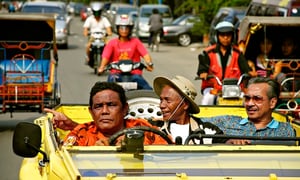Frank Beyer
That the 1965-66 massacre of 500,000 civilians, who were affiliated with the Indonesian Communist Party (PKI) and other leftist groups, was the result of a highly organised Indonesian Army plan is the central tenet of Geoffrey B Robinson’s The Killing Season.
In the preface the author tells us how outraged he is, and has been for decades, over the massacres. He still hopes those responsible for these horrors, swept under the carpet for so long, will be brought to justice. This strong preface is admirable for not pulling any punches, but also casts doubt over the objectivity of the work which follows. However, this doubt is allayed a few pages into chapter one. The work is thoroughly researched and conflicting versions of key events are well broken down and explained, as are the author’s arguments.

As the evidence does not point to a definitive answer, Robinson doesn’t force one upon us as to who exactly perpetrated the attempted coup of 30 September 1965, in which six army generals were kidnapped and killed. His point is that the official story that the coup was plotted and carried out by the leadership of the PKI, is highly unlikely to be true. The PKI at this stage had mass membership, considerable influence over President Sukarno and had been involved in the parliamentary electoral process for years, and so had a lot to lose by instigating this so-called coup. In the end the coup, or the 30 September movement, was the excuse the right-wing army, under the leadership of General Suharto, needed to oust President Sukarno from power and crack down on leftists.
How were half a million Indonesians killed in the wake of the 30 September movement? ‘Who carried out these killings and why?’ Robinson asks. The official story given by Suharto’s New Order government (1968-1998) was that the killings were a result of a spontaneous bout of civilian outrage against the PKI because of the killing and mutilation of the six generals. Robinson points out that the generals were not in fact mutilated and President Sukarno tried to let this be known. However, the army had seized control of the press and launched an aggressive propaganda campaign to demonise the PKI. The United States covertly helped with this campaign. One anecdote that made the mechanics of this clear was that the United States arranged a much needed supply of imported rice for the army that could then be released on to the market. The army claimed this rice had been found hoarded in PKI storehouses, thus further demonising the PKI while bolstering its own reputation at the same time. The United States and United Kingdom both kept quiet about the massacres in the context of their ‘anti-communist at all costs’ Cold War policies.
The Killing Season dismisses the narratives that the killings were based solely on cultural and religious factors. Robinson shows that the geographical and temporal patterns of the massacres back up the conclusion that they were orchestrated by the army and the major motivation was ideological. As shown in Joshua Oppenheimer's film The Look of Silence, the army provided logistics while civilian paramilitary groups carried out the brutal killings.
Robinson also looks into the one million people imprisoned in the wake of 30 September. He likens the conditions in prisons, especially those on the prison island of Buru, to those of Japanese World War II prisoner of war camps. He argues that torture and sexual violence were used as deliberate terror tactics and were partly a result of the brutal influence on the Indonesian military of the Japanese in World War II and the Dutch colonial government.
Later in the book Robinson describes the resistance to setting up a Truth and Justice Commission. So far, President Jokowi has refused to apologise to victims of the 1965-66 purge, and many government officials have repeatedly called for the past to be left in the past. While praising the efforts of NGOs, historians and film makers to set the record straight and talk about the killings, he writes that the government has been generally in favour of a non-judicial reconciliation program – something that he disagrees with. He makes a brief comparison with the aftermath of East Timor, where not a single Indonesian Army officer has gone to trial for human rights abuses carried out during two decades of Indonesian occupation. (Robinson was on the ground for the independence of East Timor in 1999.)
Perhaps it’s out the scope of the book, but I would have liked more about how other countries have attempted justice and reconciliation after such mass killings, and what Robinson would suggest for Indonesia – he only touches briefly on this matter in the final chapter.

Along with the films of Joshua Oppenheimer The Act of Killing and The Look of Silence, this book is recommended for those trying to understand the causes, both domestic and international, behind the massacres of 1965-66. It is also an insight into Indonesia’s continuing struggle to come to terms with this painful episode in its history.
Geoffrey B Robinson, The Killing Season: A History of the Indonesian Massacres, 1965-66 , Princeton University Press, 2018.
Frank Beyer (frank.e.beyer@gmail.com) has a degree in history from the University of Auckland. His writing has appeared in the LA Review of Books, Imperial and Global Forum and the Asian Review of Books.
